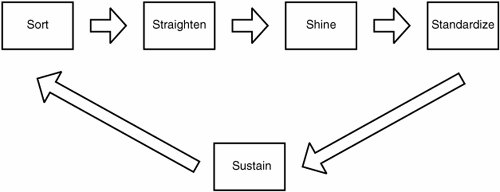5S: A Giant Step Toward a Productive Workplace Environment
| 5S is a methodology that helps create a productive workplace environment. It was initially used in Japan to lay foundations for introducing JIT. It was developed by Japanese manufacturing consultant Hiroyuki Hirano. He concluded that a large number of organizations embarking on JIT fail to realize its potential in the absence of workplace discipline and the clutter-free environment that systematic housekeeping can provide.[1] JIT, an integral component of what has come to be known as TPS, is based on a philosophy of complete elimination of waste. 5S is an integral part of what is broadly called lean concepts. It supports TPS and the principles of lean and helps reduce non-value-added activities, standardize tasks, and increase work efficiency and productivity in diverse work environments. We will discuss a little later how a 5S system meshes with powerful organization-wide interventions such as TPS and DFTS. 5S stands for the following five Japanese words, all beginning with S (see Figure 10.1):
Figure 10.1. The Five Phases of the 5S System Often a sixth S is added that stands for safety. This implies that safety should be an integral part of procedures and work habits in an organization and that safety procedures should be defined. The 5 S's (we prefer the 6 S's) support software development as a whole to be disciplined and productive. Introduced correctly, a 6S system can greatly improve operational efficiency in a workplace. It creates discipline and a clutter-free environment, thus redirecting energy to focus on vital operational goals. It also helps reduce costs of various supplies and improves safety and productivity in the workplace in addition to providing a simple housekeeping procedure. The results can be visible immediately and can lay a foundation for a major intervention such as DFTS. |
EAN: 2147483647
Pages: 394